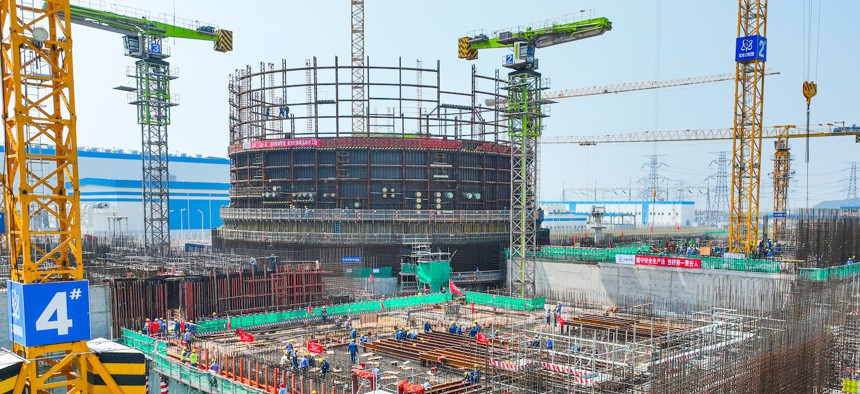
Photo taken on June 29, 2022 shows the construction site of Unit 7 of Tianwan Nuclear Power Plant in Lianyun District of Lianyungang City, East China's Jiangsu Province. CFOTO/Future Publishing via Getty Images
The Balance of Power Is Shifting Among Nuclear-Energy Titans
Russia and China have overtaken the United States as the world’s premier nuclear-power exporters. But are they comrades or competitors?
A startling statement arrived in July from Fatih Birol, executive director of the International Energy Agency: “advanced economies” no longer lead the global nuclear energy industry. Since 2017, Russian and Chinese reactor designs have accounted for 87 percent of new installed nuclear reactors worldwide. And in this area, as in others in their strategic partnership, China is gradually supplanting Russia, and is set to become the world’s leading nuclear-power producer before 2030.
Russia has long been a dominant nuclear energy power, the result of first-mover advantage and many decades of accumulated scientific expertise. One of the first countries to develop nuclear power, Russia helped China build its first nuclear reactor between 1956 and 1958. Bilateral cooperation ceased in 1959 as Sino-Soviet relations soured.
Nuclear cooperation then resumed after the USSR’s collapse. In the 1990s, Russia agreed to help China build the Tianwan Nuclear Power Plant in Lianyungang (with Russian VVER reactors), a centrifuge enrichment plant in Hanzhong, and the China Experimental Fast Reactor, or CEFR, in Beijing, among other installations. These joint projects continued the trend of Russia supplying the backbone of China’s nuclear industry: Tianwan is now China’s largest nuclear-power plant, Hanzhong its largest uranium enrichment plant, and CEFR its first foray into fast reactor technology.
Today, Russia continues to be the largest player in the nuclear energy export market by a wide margin. It produces about 35 percent of the world’s enriched uranium reactor fuel and has 34 overseas reactor units completed or under construction, with nearly $140 billion in foreign orders in 2021. The Ukraine war has scared off some potential clients, but sanctions to this point have largely spared Rosatom, Russia’s state-owned nuclear corporation.
Sino-Russian nuclear energy collaboration has been an important part of this business. In 2021, Russia and China broke ground on their largest-ever joint nuclear energy project: the installation of two new Russian VVER-1200 reactors at the Tianwan plant (the plant’s seventh and eighth units), and two more at a new plant in Xudabao. China also enlisted Russian expertise in its construction of two CFR-600 reactors: fast reactors designed by the China National Nuclear Corporation, or CNNC, that began construction in 2017. Rosatom provides fuel for these and other Chinese nuclear-power plants.
Unlike Russia’s, China’s new reactor projects are mostly domestic: 80 percent of its existing 50 nuclear reactors were constructed in the last decade, and there are plans for at least 150 more reactors in the next 15 years. But China has begun to sell its own nuclear work abroad. It has exported four reactors to Pakistan and discussed or signed contracts to build nuclear-power plants in Argentina, Turkey, the UK, and several African states.
This points to a shift in the Sino-Russian relationship in the realm of nuclear power. While China’s reliable patronage is a financial boon for Rosatom, China is now largely self-sufficient in its nuclear fuel cycle. It is further weaning itself from Russia by developing indigenous nuclear technology and diversifying its global partnerships. The Hualong One, China’s premier nuclear reactor for export, is a case in point: it was developed jointly by state-owned corporations CNNC and the China General Nuclear Power Group, or CGN, but based on French M-310 designs previously installed in Guangdong Province.
In some respects, the relationship between the two countries in the nuclear energy field mirrors the larger trends of the Sino-Russian relationship, just on a slower pace of change. While Russia may be rapidly becoming economically dependent on China, it remains the dominant power in nuclear energy, with China playing the role of junior partner. However, as Chinese nuclear power companies mature and venture beyond China, cooperation has increasingly turned into competition.
China and Russia’s main competitive advantage in the nuclear market is that their nuclear industries are state-run. Russia’s entire nuclear fuel cycle is controlled by Rosatom, while China’s is dominated by CNNC and CGN. With generous government backing, these state-owned enterprises can take contracts that would be too risky or unprofitable for private companies and offer extremely favorable deals to clients that may not be able to afford the full cost of nuclear power plant construction. For example, China is financing 85 percent of a planned $8 billion Hualong One reactor in Argentina, while Rosatom offered a similar deal for a potential project in Egypt. In this way, Russia and China can force out private competitors and use overseas nuclear contracts to advance longer-term economic and strategic interests, even if a given project is unprofitable.
By the same token, the advantages of state-backed nuclear industry increasingly make Russia and China each other’s most formidable competitors. CNNC and CGN pursue nuclear powerplant contracts in many of the same countries as Rosatom. CNNC’s Argentina deal is an example; Rosatom had previously pitched its own thousand-megawatt VVER for the country, but that deal has not progressed.
Beyond the economic benefits, nuclear powerplant contracts have geopolitical implications. Such plants take years to construct and must be maintained and refueled for decades. This can give nuclear-exporting states substantial political influence in client countries, particularly in developing countries that lack the resources and indigenous expertise to handle plant operation themselves.
The story of Russia and China’s nuclear-energy ambitions is thus one of changing power. Competition in this global market is a battle for influence, a battle the United States is losing. But it is also one that increasingly pits Russia and China against each other.
NEXT STORY: How Should We Quickly Replace Downed Satellites?



